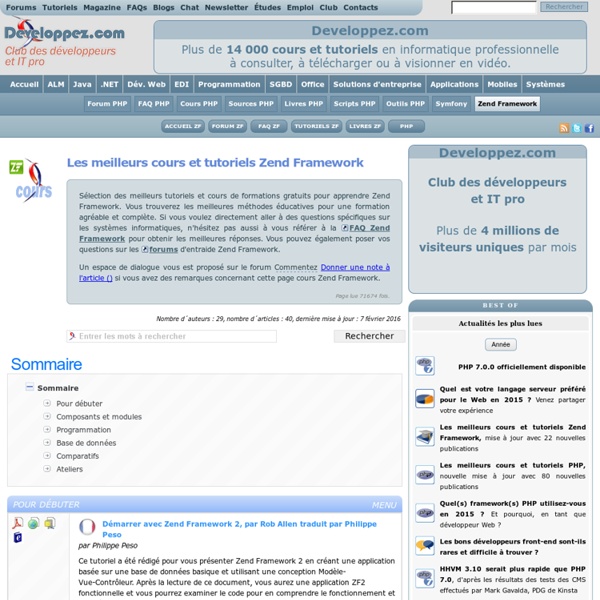



Zend Framework Zend\View\Renderer\PhpRenderer“renders” view scripts written in PHP, capturing and returning the output. It composes Variable containers and/or View Models, a plugin broker for helpers, and optional filtering of the captured output. The PhpRenderer is template system agnostic; you may use PHP as your template language, or create instances of other template systems and manipulate them within your view script. Anything you can do with PHP is available to you. Basic usage consists of instantiating or otherwise obtaining an instance of the PhpRenderer, providing it with a resolver which will resolve templates to PHP view scripts, and then calling its render() method. Instantiating a renderer is trivial: Zend Framework ships with several types of “resolvers”, which are used to resolve a template name to a resource a renderer can consume. We suggest using the AggregateResolver, as it allows you to create a multi-tiered strategy for resolving template names. Now, let’s render something. Note
Zend Framework From its home page, XML-RPC is described as a ”...remote procedure calling using HTTP as the transport and XML as the encoding. XML-RPC is designed to be as simple as possible, while allowing complex data structures to be transmitted, processed and returned.” Zend Framework provides support for both consuming remote XML-RPC services and building new XML-RPC servers. To show how easy is to create XML-RPC services with Zend\XmlRpc\Server, take a look at the following example: Note It is necessary to write function and method docblocks for the services which are to be exposed via Zend\XmlRpc\Server, as it will be used to validate parameters provided to the methods, and also to determine the method help text and method signatures. An example of a client consuming this XML-RPC service would be something like this:
Zend Framework Overview The Message class encapsulates a single email message as described in RFCs 822 and 2822. It acts basically as a value object for setting mail headers and content. If desired, multi-part email messages may also be created. The Message class is simply a value object. Quick Start Creating a Message is simple: simply instantiate it. Once you have your Message instance, you can start adding content or headers. You can also add recipients to carbon-copy (“Cc:”) or blind carbon-copy (“Bcc:”). If you want to specify an alternate address to which replies may be sent, that can be done, too. Interestingly, RFC822 allows for multiple “From:” addresses. By default, the Message class assumes ASCII encoding for your email. If you wish to set other headers, you can do that as well. Sometimes you may want to provide HTML content, or multi-part content. If you want a string representation of your email, you can get that:
Zend Framework Zend\Feed provides functionality for consuming RSS and Atom feeds. It provides a natural syntax for accessing elements of feeds, feed attributes, and entry attributes. Zend\Feed also has extensive support for modifying feed and entry structure with the same natural syntax, and turning the result back into XML. Zend\Feed consists of Zend\Feed\Reader for reading RSS and Atom feeds, Zend\Feed\Writer for writing RSS and Atom feeds, and Zend\Feed\PubSubHubbub for working with Hub servers. In the example below, we demonstrate a simple use case of retrieving an RSS feed and saving relevant portions of the feed data to a simple PHP array, which could then be used for printing the data, storing to a database, etc. Note Be aware Many RSS feeds have different channel and item properties available. Your $channel array now contains the basic meta-information for the RSS channel and all items that it contained.
Zend Framework ZendI18n comes with a complete translation suite which supports all major formats and includes popular features like plural translations and text domains. The Translator component is mostly dependency free, except for the fallback to a default locale, where it relies on the Intl PHP extension. The translator itself is initialized without any parameters, as any configuration to it is optional. A translator without any translations will actually do nothing but just return the given message IDs. Adding translations To add translations to the translator, there are two options. To add a single file to the translator, use the addTranslationFile() method: The type given there is a name of one of the format loaders listed in the next section. Note For each text domain and locale combination, there can only be one file loaded. When storing one locale per file, you should specify those files via a pattern. Supported formats The translator supports the following major translation formats: Caching
Zend Framework Zend\Config is designed to simplify access to configuration data within applications. It provides a nested object property-based user interface for accessing this configuration data within application code. The configuration data may come from a variety of media supporting hierarchical data storage. Currently, Zend\Config provides adapters that read and write configuration data stored in .ini, JSON, YAML and XML files. Using Zend\Config\Config with a Reader Class Normally, it is expected that users would use one of the reader classes to read a configuration file, but if configuration data are available in a PHP array, one may simply pass the data to Zend\Config\Config‘s constructor in order to utilize a simple object-oriented interface: As illustrated in the example above, Zend\Config\Config provides nested object property syntax to access configuration data passed to its constructor. Using Zend\Config\Config with a PHP Configuration File